![]()
![]()
![]()
Use LEFT and RIGHT arrow keys to navigate between flashcards;
Use UP and DOWN arrow keys to flip the card;
H to show hint;
A reads text to speech;
13 Cards in this Set
- Front
- Back
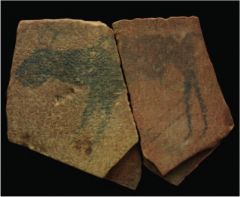
1. Apollo 11 Stones- Namibia - 25,500–25,300 B.C.E. - organic or mineral stain on cave wall
Content - This is the silhouette of an animal painted on a cave wall. It is the only focus of the artwork. The subject matter, an animal, was very significant to prehistoric people that relied on animals for survival.
Style -The artist probably brushed on the organic/mineral stain. The animal depicted is very basic and two dimensional, viewed directly from its left side. It is a black-ish color. There is no sense of space.
|
Contextual Analysis This piece was found painted on a stone cave wall, which were the most important structures during the time, for shelter, storage, etc. It represents the natural world, which is also depicting spiritual beliefs, since animals were so necessary that they became almost spiritual. Paintings like this could be used to convey to other clans that animals or a major migration route were nearby.
|
|
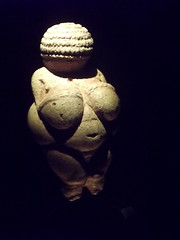
Venus of Willendorf - Austria - c. 25,000 BCE p. 25 - carved stone
Content - This piece is a carved statuette icon, depicting a voluptuous woman with emphasized breasts and stomach. The theme is fertility and reproduction, which is necessary for survival and therefore has spiritual significance.
Style -This figurine is carved from stone, using another stone tool. It was then painted with an ochre stain. The artist uses shape to emphasize the breasts and stomach, and texture to show hair or a woven hat. The face, arms, and feet are not emphasized, because they are not important to the theme of reproduction.
|
Contextual Analysis This piece has an emphasis on fertility and reproduction, which is essential to survival. It shows that the artist had an understanding of how the body works, but still thought of reproduction as a spiritual thing. Perhaps it was meant to be given to young girls or pregnant women for good luck. The statuette is very small, meant to be carried around. This is because the nomadic clans could not stay in one place-- animals migrate, and food and water run out. She doesn't have any feet, which shows that she wasn't meant to stand but rather be carried in a hand or pocket. |
|

2. Great Hall of the Bulls- Lascaux, France / Paleolithic Europe - 15,000–13,000 B.C.E. - organic/mineral stain on cave wall
Content -This part of the cave paintings include bulls, maybe ancient horses, and deer. They vary in color, texture, and pattern, and are overlapping. Like the Apollo 11 Stones, the subject matter, animals, were very significant to prehistoric people that relied on animals for survival.
Style -The artist(s) of these paintings used a more advanced style than previous cave paintings such as the Apollo 11 Stones. The animals are still 2 dimensional, but they are colorful, textured, patterned, and generally more detailed. This means the artist was more skilled or simply more observant of the environment. The image is fitted to the actual cave walls; it uses ledges and the ground to create a frame. Curved, long, and lean lines create undulation throughout the paintings so the animals look like they are running. Dots create texture. There is also a sense of background and space created by the overlapping of animals. |
Contextual Analysis Caves were really important to the artist. And with art, caves became more than just shelter-- it meant that they caves were spiritual, near lots of animals, and that nomadic clans possibly stayed there longer than others. Similar to most prehistoric art, these paintings depict animals, which were the center of man's world.
|
|

Cave Paintings - Altamira, Spain - c. 12,000 BCE - mineral/organic pigments
Content -These cave paintings are once agin of animals, what look like bulls of some sort. Theses creatures were still very significant for survival, but these particular paintings depict them more majestically than others.
Style -more 3-dimensional -brushed, "blown" pigment off of hand -bright red much more prominent than in Lascaux -texture, detail, fur, inner lines -undulation -more stagnant (less MIMETIC) -not overlapping, no layering of images -similar image and style is repeated, suggesting that it was probably just one artist
|
Contextual Analysis Caves were really important to the artist. And with art, caves became more than just shelter-- it meant that they caves were spiritual, near lots of animals, and that nomadic clans possibly stayed there longer than others. Similar to most prehistoric art, these paintings depict animals, which were the center of man's world. |
|
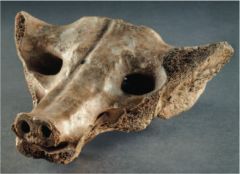
3. Camelid sacrum in the shape of a canine- Tequixquiac, central Mexico - 14,000–7000 B.C.E. - carved bone
Content -This is a canine head carved out of bone from an extinct, camel-like animal. The bone used is a sacrum, around the pelvic area, which could show significance surrounding reproduction.
Style The artist worked with the shape of bone and used a subtractive technique.
|
Contextual Analysis -natural material putting meaning into object -possibly a mask used in ritual -understanding of how to use natural materials to create tools -not very big, brought with -animism...animals more than just food, but spiritual |
|
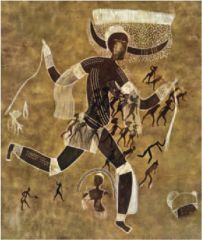
4. Running horned woman- Tassilin’Ajjer, Algeria, 6000–4000 B.C.E.
Content -This piece is of one central figure, a horned woman, surrounded by smaller, simple figures. The woman has skin ornamentation as well as some clothing/arm and leg decoration. Some of the less significant figures are headless, suggesting a possible battle scene opposed to a ceremonial scene. The significance of the content lies in the subject matter- humans, not animals- and that it tells some sort of story.
Style -mineral pigment on stone wall -white pigment=some form of chalk -moves away from silhouettes and simple contours -a lot of ornamentation, detail, clothing, decoration -main woman drawn over other figures, use of transparent pigment -lots of movement -contrast between white and dark brown
|
Contextual Analysis - This piece depicts humans rather than animals, revealing that at the time survival became more than just animals, but also the existence of a group of humans. It is part of a group of images in the area including engravings and ceramics, leading historians to believe that it was an established site. Evidence of successive peoples over time means that these people had moved on from hunter-gatherer nomadic clans and could establish much more permanent residences and cultures. The woman's horns could be ceremonial of some sort; the rain above her head suggests a possible rain dance. The artist(s)' culture still had very close connection with their natural environment. Some of the background figures don't have heads, which could be intentional in portraying a battle of some sort. The work is depicting an event or story, which was a huge change in the purpose and function of art. People wanted to record their story, and about themselves as a culture, instead of just focusing on their survival.
|
|
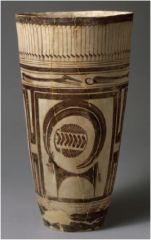
5. Bushel with ibex motifs- Susa, Iran, 4200–3500 B.C.E.
Content -Ceramic bushel (tall pot) with motif of ibex (mountain goat from area) -dogs, maybe hunting dogs-ibex were probably a food source -tall skinny birds along the top -lots of animal imagery still -typical shape and form of ceramics in area, but not the level of decoration as this one, which means this has some importance, possibly funerary, or for storage of some kind
Style -linear style, silhouettes -advanced decoration work -still mineral stains -stylized and simplified, but still accurate, detailed -very exaggerated qualities in the animals -lines compliment form |
Contextual Analysis - This bushel could have been used for storage of grain, water, or basically anything. It could have also been a gift to a significant person, or it might have had a ritualistic purpose. This piece was found in a funerary area, suggesting that it is possibly a funerary object. If it was associated with funerary practices, it is evidence of a new intro to art's purpose and the meaning of death. Was it used for funerary ashes? Mummification? A gift for the afterlife? Whatever its purpose, the bushel signifies a change from hunting and gathering clans to the earliest civilizations.The people were building a even more intimate understanding of environment, since they could understand how to find and work clay, fire, and have control over heating.
|
|
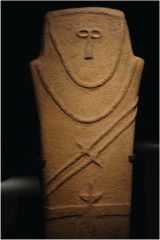
6. Anthropomorphic stele-Arabian Peninsula, 4th millennium B.C.E.
Content -This piece is a neolithic Stele, or stone marker, meant to stand upright. It is possibly related to a tombstone, or it might be in recognition of someone's importance. The knifes suggest some sort of heroic recognition. Many others have been found in the area.
Style -carved stone (incised) -stylized head, not realistic -really simple
|
Contextual Analysis -Since this piece is a marker of sorts for an individual of some significance, it signifies a focus on individual existence, rather than clan or general human figure. It is communicating individuality. |
|
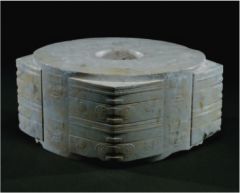
7. Jade Cong - Liangzhu, China - 3300–2200 B.C.E.
Content -carved jade -have been several found -new material...special stone -most of the ones found have cylindrical forms, all pretty high level of decoration -Their function and meaning are completely unknown. -The main types of cong have a square outer section around a circular inner part, and a circular hole - The main decoration on congs from this period are beast-man faces on the corners, which may refer to spirits or deities.
Style -incised decoration (slightly carved) -precision |
Contextual Analysis -It is unclear what such congs were used for, but they were possibly ornamentation, trade items, or maybe just for significant people. |
|

8. Stonehenge - Wiltshire, UK. -Neolithic Europe - 2500–1600 B.C.E.
Content - These are slightly carved, stacked stone pieces - The stones are arranged in a pattern in coherence with eclipses and astronomical cycles -served as calendar, marked seasons
Style -Precision, symmetry, unity -optical corrections so stones look vertical from ground - Stacked in megaliths (Post on sides and lintel on top) which is a huge architecture technique today - Lentils acctually conform to the curve of the circle |
Contextual Analysis The creators of Stonehenge were able to manipulate their environment for their own purposeful use. It serves as a sort of calendar; the sunrise on midsummer's day and sunset on midwinter's day line up with the rocks. Stonehenge was most likely a religious center, but could have also been used as a reference for migration and farming. |
|
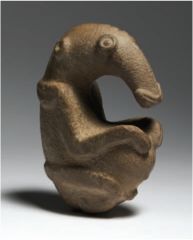
9. The Ambum Stone - Ambum Valley, Enga Province, Papua New Guinea - c. 1500 B.C.E.
Content -some sort of animal...ancient anteater? -rounded belly...intentional? for balance?
Style -subtract large amount of stone to create free-standing figurine -not incised- 3D -tough greywacke stone would have involved many weeks of laborious chipping and hammering at the surface with stone tools.
|
Contextual Analysis -Significance and function of the Ambum stone remains obscure, as little is known about the people who produced it. Present-day people in the region use similar figurines as spirit stones in sorcery and other rituals.
|
|
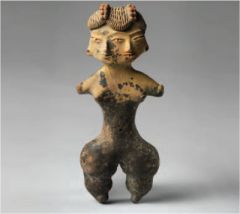
10. Tlatilco female figurine -Central Mexico, site of Tlatilco - 1200–900 B.C.E.
Content -small figurine, statuette -compare to Venus of Willendorf -female probably -emphasis around hips -two faces..WHY?
Style -ceramic..understanding of manipulating natural materials -painted decoration
|
Contextual Analysis -The purpose of this figure could have been to symbolize religious ideas such as duality. Due to the pieces size, we know that it was meant to be portable, but it was not meant to be a free standing piece. |
|
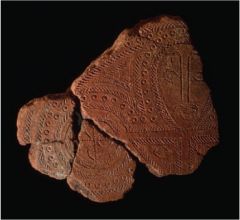
11. Terra cotta fragment - Solomon Islands, Reef Islands / Lapita - 1000 B.C.E.
Content -intricate repeating geometric patterns that occasionally include anthropomorphic faces and figures -Many Lapita ceramics are large vessels thought to have been used for cooking, serving, or storing food. -Some of the designs found on Lapita pottery may be related to patterns seen in modern Polynesian tattoos and barkcloth.
Style -The patterns were incised into the pots before firing with a comblike tool used to stamp designs into the wet clay -Each stamp consisted of a single design element that was combined with others to form elaborate patterns. |
Contextual Analysis The pots that pieces like this made up were probably used for cooking, storing, or serving food. The design sometimes included anthropomorphic or zoologic patterns that may signify a specific person, or the importance of the individual in general. |

